Middle Serchio Valley

Historically and morphologically tied to the nearby Garfagnana, the Middle Valley develops along the course of the Serchio River. It was precisely the presence of this hydrographical basin, as well as the birth of important communication routes towards Padania, that favoured the development since the medieval epoch of the area’s numerous historical and manufacturing centres, particularly those tied to the paper-making sector.
Among the localities of greatest historical-scientific interest in the region, we must include the spa of Bagni di Lucca, which is reached from the main city of the province on the SS12 of the Abetone and Brennero. Before entering town, we advise a brief stop at Borgo a Mozzano, just over 20 kilometres from Lucca, to admire the scenographic Maddalena Bridge.
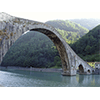
The Maddalena Bridge owes its name to the sixteenth-century aedicule (no longer existent) on the left bank of the Serchio River in the vicinity of Borgo a Mozzano. Also known as Ponte del Diavolo (Devil’s bridge) for an old legend, it was probably built by order of Countess Mathilde of Canossa. With its peculiar "donkey back" structure and asymmetrical arches, it is a wonderful example of medieval engineering. It was later restored by Castruccio Castracani, condottiere and lord of Lucca in the early 14th century. In order to preserve its structure integral, in 1670 the General Council of the Republic of Lucca prohibited the transportation of millstones over it. A flood in 1836 caused serious damage to the structure, but the greatest alteration to the work occurred in the early 20th century when a new arch was made to enable the passage of the railway. The "donkey back" of this spectacular bridge can today be crossed on foot.
(Graziano Magrini)
Along the same road, in the locality of Fornoli, you can also see the Chain Bridge, a faithful reconstruction of the nineteenth-century bridge by Lorenzo Nottolini, a work of a great engineering value.
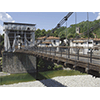
Begun in 1840 by Lorenzo Nottolini on commission to Duke of Lucca Carlo Lodovico di Borbone, the suspension bridge with iron chains over the Lima Stream connects Fornoli (Bagni di Lucca) and Chifenti (Borgo a Mozzano).
For its time, the bridge presented innovative technological solutions, which the author had acquired during a recent trip to England, where there were already illustrious models like Hammersmith Bridge in London and Menai Bridge in Bangor, Wales. Moreover, the use of iron in the construction of suspension bridges could already be seen in Florence, which had two important examples built by the French company of brothers Marc and Jules Séguin: the San Leopoldo bridge at the Parco delle Cascine , and the San Ferdinando bridge near the gate of San Niccolò. Nottolini’s work was later interrupted by bureaucratic problems tied to the passage of the Duchy of Lucca to the Grand Duchy of Tuscany (1847).
Only after the Unification of Italy were works resumed and terminated, and the bridge was inaugurated in 1860. Mined by retreating German troops during World War II (all of the support structures were blown up), the bridge was then reconstructed on its original plan, thanks to the efforts of engineer Luigi Pfanner, and inaugurated in 1953. On the World Monuments Watch list of the one-hundred world sites to save, the bridge has recently been subjected to restoration.
Nottolini also designed other bridges on Lucca territory, though without the innovative conception of the Chains Bridge. These include the bridge of Monte San Quirico near Lucca, over the Serchio River, the stone bridge with a lowered arch over the Fegana stream, and the bridge with round arch over the Camaione stream (1839-1841, 1946) near Bagni di Lucca.
(Graziano Magrini)
Getting back on SS12, after a few kilometres, you come to Bagni di Lucca whose spas were already famous in the Middle Ages for the therapeutic properties of their waters, and were frequented by illustrious historical figures.
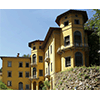
Bagni di Lucca is a thermal station of very ancient origin, known in the Middle Ages by the name of Bagni di Corsena. A sonnet by Franco Sacchetti dedicated to Michele Guinigi shows how highly these thermal waters were considered:
"My dear Michele, when I look around me
At the place, and the virtue of this fountain,
I must believe that never under Phaeton
Was there a vein of such sweet waters .Fine air has this place,
Flowing rivers at the foot of every mount,
Your costumes, and your women count,
With sweet enticing songs of sirens;Wine, meat, fish, and all the wholesome fruits
And every other thing that comforts,
In which it seems this paradise delights.Here every malady is cured, or fades away;
And even more, what is most sovereign,
Is that such virtue is by love accompanied."On a less poetic but more scientific level were both Gentile Gentili da Foligno, who first described the therapeutic value of these springs, in the first half of the 14th century, and Ugolino da Montecatini. The latter, in his famous Tractatus de Balneis (Città di Castello, 1417), wrote that the water of the baths "is most famous and devoid of any odour or taste... These baths are highly effective for pains in the joints and for nervous disorders, especially those caused by the cold. They are suitable for neuralgic pains and for diseases of the joints occurring either spontaneously or due to sprains or as the result of previous torture. They dry up ulcers and cure those that heal with difficulty. They are beneficial to childless women, allowing them to conceive when the sterility is due to humidity in the uterus, because their drying effect is useful in all of those diseases where drying is necessary."
The thermal station, which attracted important personages, was also praised by the philosopher Michel de Montaigne, who stayed there for over two months in 1581 seeking a cure for his kidney stones. The waters of the Baths were described by eminent physicians such as Gabriele Falloppia and Andrea Bacci in the 16th century, Lodovico Martini and Fabrizio Ardizzone in the 17th, Giuseppe Duccini, Giuseppe Zambeccari and Domenico Moscheni in the 18th century. Duccini, for example, stressed their effectiveness in expelling kidney stones: "The water of the Villa is marvellous, especially for the expulsion of Kidney stones, and Gravel, for cleansing ulcers and internal as well as external sores. [...] The patient staying in the Baths, and remaining there at least an hour with all due quiet, the skin is necessarily dampened little by little, and its recesses and pores open imperceptibly due to the heat of said Baths; so that, this warm water insinuating itself inside us, not only releases the internal organs, but also expands the paths, and the ducts of the kidneys, within which the stones were enclosed, and in this way gently promotes their expulsion". Slightly after the middle of the 19th century, the chemical and therapeutical properties of the various springs were analyzed by Alessandro Carina, at the time head physician of the baths.
Under the rule of Elisa Bonaparte Baciocchi, Bagni di Lucca flourished, becoming one of the most famous thermal centres in Italy and abroad, rivalling the nearby Baths of San Giuliano and those of Montecatini. Subsequently, the little town developed still further, both as a curative centre and as a resort, becoming one of the favourite stopping places in the cultured, refined nineteenth-century gran tour.
The waters gush from fifty-three springs at temperatures ranging from 39 to 54 degrees Centigrade. There are seven historic thermal establishments at Bagni di Lucca: in the Bagni Caldi locality is the Jean Varraud establishment, the only one still in operation at the moment, and the Bagno San Giovanni; at Ponte a Serraglio are the Bagno Cardinali, today a private residence, the Bagno Bernabò, the Docce Basse, known also as Bagno Rosso, and the former Demidoff Hospital; lastly, above the main town is Bagno alla Villa, which remained in operation until the 1950s.
(Graziano Magrini)
Along the Lima stream, near the spa, you can still admire the buildings of the former Bianchi paper-mill, one of the many industries that set up on the territory of Lucca in the late 19th century.
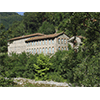
Built in 1876 along the Lima stream and named Vittoria, it received honourable mention at the Milan Exposition of 1881 for the quality of its products. In 1913, producing 1000 kg of straw paper per day, the paper-mill was equipped with a steam turbine, so-called "continuous" machinery, and two "Dutch" machines. The straw was macerated in tanks with milk of lime; the pulp thereby obtained was milled in stone vats and then passed in the continuous machine.
The complex consists of three buildings of different dimensions, characterised by the typical arched openings necessary to ventilate the rooms where the sheets of paper were dried. The main building, which housed the machinery, still today has the tanks and four vats. For representational motives, the street facade presents decorations characterised by monochrome medallions with bas reliefs between the window arches.
(Graziano Magrini)
The most eloquent token of the development of the paper-making sector on Lucca territory in the course of the 19th century, however, consists in the spectacular sequence of plants still visible today along SP55 that from Bagni di Lucca climbs up to Villa Basilica.
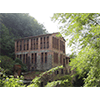
Paper-making activity boasts an ancient origin in Villa Basilica: in 1344, the Book of Taxes reports several transfers of paper to Pescia. Between the 16th and 17th centuries, and even more so in the 18th century, the number of "paper-mills" sited in the Villa area along the Pescia Minore stream, slowly but progressively increased, also thanks to the thriving publishing industry of Lucca. Between 1830 and 1840, Stefano Franchi from Villa Basilica invented a method for obtaining paper from straw. The factories in the area started producing wrapping paper, abandoning the previous activity of making paper for writing and printing, and making Villa Basilica an important production centre of straw paper. Still in the mid 20th century, the Commune of Villa and the neighbouring Commune of Pescia had the highest concentration of paper-mills in Italy. Today, the number has dropped, but the production is still of excellent quality.
Going back up the road that from Collodi leads to Villa Basilica, a sort of scenographic open-air manufacturing museum unfolds with a sequence of paper-mills with their typical structure, easily recognisable by the arched openings on the tops of the factories, where paper was dried.
(Graziano Magrini)
****************************
Texts by Elena Fani
English translation by Victor Beard
Last update 23/gen/2008



 = libraries and archives
= libraries and archives  = scientific research centers
= scientific research centers  = memorial places of scientists
= memorial places of scientists = public health places
= public health places = places of science and worship
= places of science and worship = places of technology
= places of technology  = museums and collections
= museums and collections  = villas and gardens of science
= villas and gardens of science

